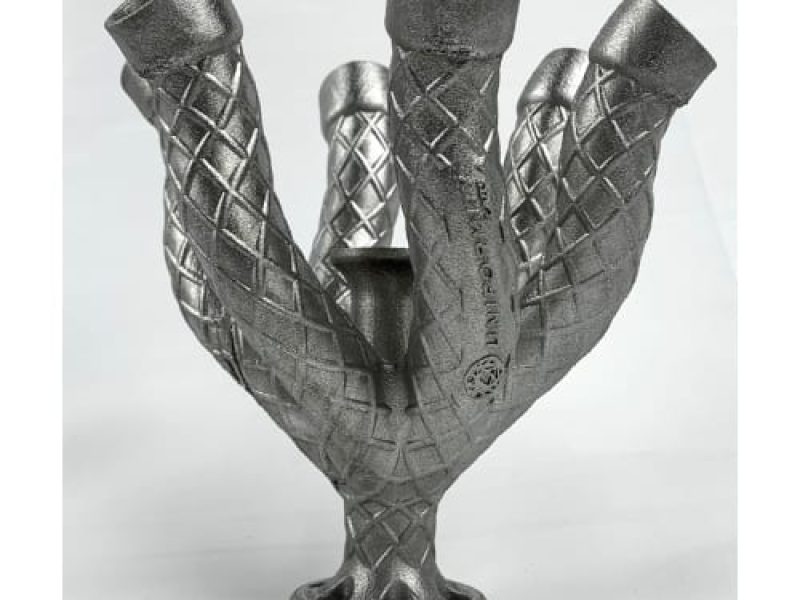
UNIFORMITY LABS POWDER PROVIDES MORE REPEATABLE AND REPRODUCIBLE MECHANICAL PROPERTIES ACROSS THE BUILD BED, PRINTED AT FAR HIGHER THROUGHPUT.
Watch the AM News LIVE Coverage
May 1, 2023 – Fremont, CA – Engineered materials company Uniformity Labs announces the availability of its UniFuse™ IN625 Nickel Alloy and optimized parameters for L-PBF printing at 60um layer thickness.
Uniformity Labs has now designed high-density multimodal Inconel 625 powder and 60um layer thickness High-Performance Scanning (HPS) parameters for printing in machines with 400W lasers. Uniformity’s powder can also be printed under typical scan parameters at different layer thicknesses and laser powers with improved mechanical properties or with increased laser speed and throughput at comparable properties.
In one example build of a part typically printed in Inconel 625, Uniformity HPS parameters at 60um layer thickness and 370W power achieved a 2.1X faster exposure time and comparable or superior mechanical propertiescompared to competitors’ 40um layer thickness scan strategies targeting best-in-class mechanical properties. This throughput improvement is typical for UniFuse™ IN625 builds.
The higher tap density and optimized particle size distribution of Uniformity multimodal powers create a highly uniform, denser powder bed, yielding more repeatable part builds at the highest throughput. This enables customers to utilize Uniformity powders to produce parts with improved and stable mechanical properties, even while printing at significantly higher build rates.
“We continue to demonstrate outsized value to our customers, harmonizing AM materials and processes to deliver production-scale additive manufacturing,” said Uniformity founder and CEO Adam Hopkins. “Our powders deliver repeatable mechanical properties and surface finish uniformly across the print bed even when printing at throughputs that greatly exceed those possible with other powders. Our No Compromise approach to AM enables our customers to realize cost-effective serial production.”
Uniformity Labs is addressing the industry challenge of economically achieving serial production in AM by developing and producing its highly advanced ultra-low porosity metal powder feedstock. Currently in production under the product brands UniFuse™ (for L-PBF) and UniJet™ (for binder jetting), and with its High-Performance Scanning strategies, Uniformity Labs has dramatically improved the ability to produce high-quality parts repeatedly and at scale – allowing additive manufacturing to become an increasingly better-established serial production tool.
This announcement follows the recent availability of a range of steel, aluminum, and titanium powders under the brand UniFuse™ for L-PBF and UniJet™ for binder jetting, bringing our material portfolio to 13 high-density powders, with many others nearing availability. Datasheets and use cases can be found here.
UniFuse™ IN625 400W Performance Mechanical and Density Information
At a glance, mechanical and density properties for as-printed material are listed below:
- 60um layer thickness, 400W
- 99.98% density, 2.1 times the throughput with comparable properties compared to competitor 40um layer thickness printing.
- Ultimate Tensile Strength (Rm z bar) – 948 ± 8 MPa
- Ultimate Tensile Strength (Rm xy bar) – 1039 ± 9 MPa
- Yield Strength (Rp0.2 z bar) – 585 ± 11 MPa
- Yield Strength (Rp0.2 xy bar) – 695 ± 26 MPa
- Fracture Elongation (A z bar) – 47 ± 4
- Fracture Elongation (Axy bar) – 40 ± 6
- Surface roughness in the z direction, no treatment (um) 8.5 ± 1.2
###
About Uniformity Labs
Uniformity Labs develops breakthrough material and software solutions to accelerate and expand global commercial/industrial 3D printing (AM) markets. Its patented technology uniquely enables fully dense printing with minimal shrinkage of binder jetting materials, delivering significant cost savings, speed, and quality improvements across all mainstream AM printers. Uniformity’s feedstock materials and print processes dramatically impact the AM value chain by increasing the reliability and efficiency of printing.
Original Press Release


